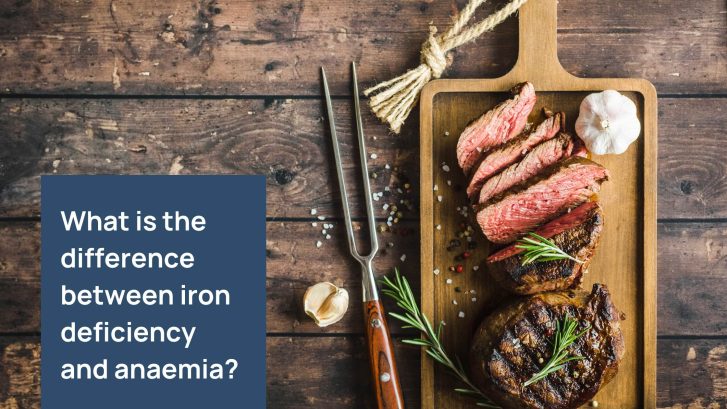Iron plays a crucial role in maintaining the body’s overall health, yet many people grapple with iron-related conditions without fully understanding their implications. Two terms often used interchangeably are iron deficiency and anaemia, leading to confusion about their differences. While interconnected, these are distinct conditions with different causes, symptoms, and treatments.
In this blog, we’ll unravel the intricacies of iron health and clarify the difference between iron deficiency and anaemia.
What is Iron Deficiency?
Iron deficiency occurs when the body has insufficient iron to meet its needs. Iron is essential for producing haemoglobin, a protein in red blood cells that carries oxygen throughout the body. Without enough iron, various bodily functions may begin to suffer.
Causes of Iron Deficiency
Several factors can contribute to low iron levels, including:
- Inadequate dietary intake: Diets low in iron-rich foods, such as red meat, leafy greens, and fortified cereals, can lead to deficiency.
- Increased iron requirements: Pregnant individuals, adolescents during growth spurts, and menstruating women often require more iron.
- Poor absorption: Conditions like celiac disease, inflammatory bowel disease, or bariatric surgery can impair iron absorption.
- Blood loss: Heavy menstrual periods, gastrointestinal bleeding, or surgery can result in significant iron loss.
Symptoms of Iron Deficiency
Early signs of iron deficiency may be subtle, making it easy to overlook. These include:
- Fatigue and weakness
- Difficulty concentrating
- Cold hands and feet
- Pale skin or mucous membranes
- Brittle nails or hair loss
Left untreated, iron deficiency can progress to anaemia, a more severe condition.

What is Anaemia?
Anaemia is a condition in which the number of healthy red blood cells or the amount of haemoglobin is below normal, leading to reduced oxygen delivery to tissues. Iron deficiency anaemia is the most common type, but anaemia can have other causes, such as vitamin deficiencies, chronic diseases, or genetic disorders.
Causes of Anaemia
While iron deficiency is a leading cause of anaemia, other contributors include:
- Vitamin deficiencies: Insufficient vitamin B12 or folate can impair red blood cell production.
- Chronic diseases: Conditions like kidney disease, cancer, or autoimmune disorders can suppress red blood cell production.
- Blood disorders: Sickle cell anaemia or thalassemia are genetic conditions affecting red blood cell health.
- Bone marrow disorders: Diseases like leukaemia can hinder red blood cell production.
Symptoms of Anaemia
Anaemia symptoms are often more pronounced than those of iron deficiency, reflecting the body’s struggle to function without adequate oxygen. Common symptoms include:
- Severe fatigue and lack of energy
- Shortness of breath, especially during physical activity
- Dizziness or light-headedness
- Rapid or irregular heartbeat
- Headaches
- Chest pain in severe cases
Iron Deficiency vs. Anaemia: Understanding the Difference
The primary distinction lies in scope and severity:
- Iron Deficiency is a lack of sufficient iron in the body, which may or may not lead to anaemia.
- Anaemia is a diagnosed condition characterised by a reduced number of healthy red blood cells or haemoglobin, often as a result of iron deficiency but not always.
Think of iron deficiency as the precursor to anaemia. If the body does not correct iron levels, iron deficiency can progress to iron deficiency anaemia, where the symptoms are more severe, and the impact on health is greater.
| Aspect | Iron Deficiency | Anaemia |
| Definition | Insufficient iron to meet body’s needs. | Reduced red blood cells or hemoglobin. |
| Causes | Dietary issues, absorption problems, or loss of iron. | Often caused by iron deficiency but includes other factors. |
| Symptoms | Mild fatigue, pale skin, brittle nails. | Severe fatigue, shortness of breath, dizziness. |
| Diagnosis | Low serum ferritin and iron levels. | Low haemoglobin and haematocrit levels. |
| Treatment | Dietary changes, iron supplements. | Depends on cause (iron, B12, folate, etc.). |
Key Differences at a Glance
Diagnosing Iron Deficiency and Anaemia
Accurate diagnosis is essential to address these conditions effectively. Blood tests are typically used to identify the underlying issue.
- Iron Deficiency Tests: Serum ferritin (storage iron) and transferrin saturation levels measure the body’s iron reserves.
- Anaemia Tests: Haemoglobin, haematocrit, and red blood cell indices help determine if anaemia is present and its severity.
For individuals experiencing symptoms like chronic fatigue or dizziness, consulting a healthcare professional is critical.
Treatment Approaches
The treatment for iron deficiency and anaemia depends on their causes. Here’s how they’re generally managed:
Treating Iron Deficiency
- Dietary Changes: Incorporating iron-rich foods such as lean meats, fish, spinach, lentils, and iron-fortified cereals is the first step.
- Iron Supplements: Ferrous sulfate or ferrous gluconate supplements are commonly prescribed.
- Addressing Underlying Issues: Treating conditions like heavy menstrual bleeding or gastrointestinal disorders is vital.
Treating anaemia
- Iron Therapy: For iron deficiency anaemia, iron supplementation is necessary.
- Vitamin Supplementation: anaemias caused by vitamin B12 or folate deficiencies require targeted supplementation.
- Blood Transfusions: Severe anaemia cases may require transfusions to quickly restore red blood cell levels.
- Treating Chronic Conditions: Addressing diseases like kidney failure or cancer is crucial to resolving anaemia caused by these issues.
Prevention: Supporting Iron and Blood Health
Prevention is often easier than treatment. Here are tips to maintain healthy iron levels and reduce the risk of anaemia:
- Consume a Balanced Diet: Include a variety of iron-rich and vitamin-rich foods. Pair iron sources with vitamin C-rich foods (e.g., citrus fruits) to boost absorption.
- Monitor Iron Needs: Pregnant women, vegetarians, and athletes may need to pay extra attention to iron intake.
- Routine Checkups: Regular blood tests can catch deficiencies before they progress to anaemia.
Final Thoughts: Know the Difference, Protect Your Health
Understanding the difference between iron deficiency and anaemia is key to safeguarding your health. While iron deficiency is a common issue, it doesn’t always lead to anaemia. Recognising the early symptoms of both conditions and seeking medical advice promptly can prevent complications and ensure effective treatment.
You can take your health into your own hands and make the first step by purchasing an at-home Ferritin Rapid Test that tests for low iron. Learn how you use the test and skip doctor wait times. You get an instant result, giving you peace of mind and allowing you to manage your own health.
If you’re experiencing fatigue, dizziness, or other concerning symptoms, consult a healthcare provider to identify the root cause and take steps toward recovery. With the right approach, both iron deficiency and anaemia are manageable, paving the way for better health and vitality.
By unraveling the intricacies of iron health, we empower ourselves to lead healthier, more energetic lives. Share this blog with someone who might find it helpful!

